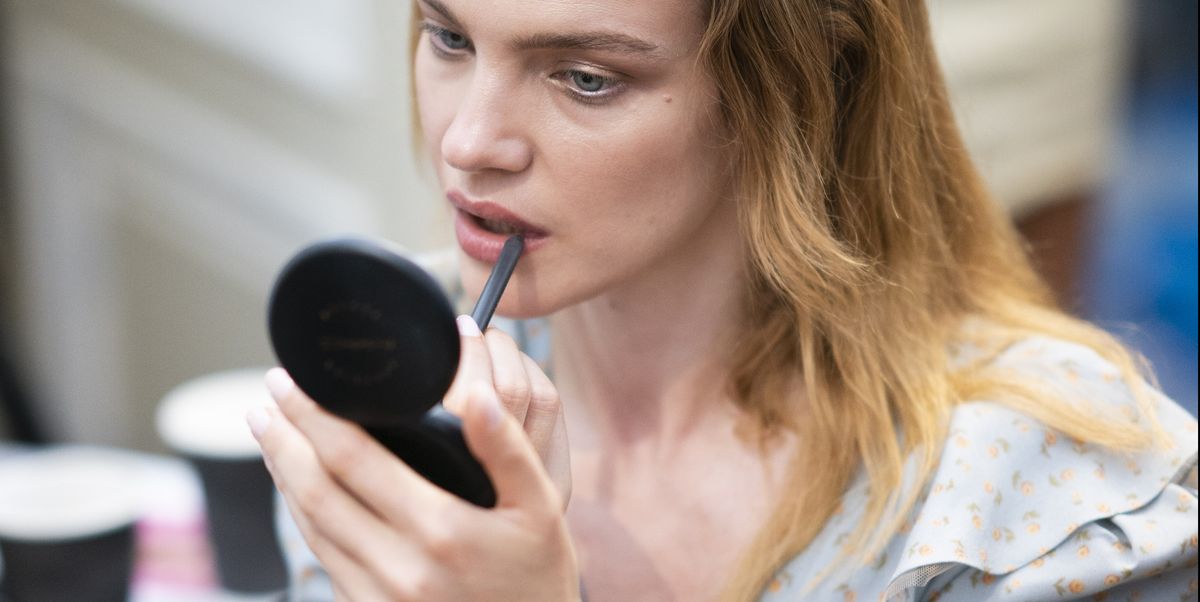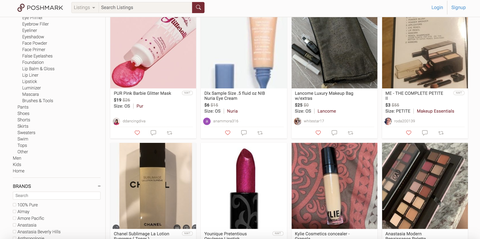I spent the last two days talking about secondhand cosmetics to anyone who spoke with me: my husband, friends, acquaintances, an acupuncturist, dermatologists, and straight up strangers. Every time I broached the subject, I got the most visceral reactions that ranged from shock to horror (“Ew, like, used makeup?” asked a friend, her face scrunched up in disgust).
And yet, there’s a demand for used or pre-owned products. As reported by the Business of Fashion, the trend is big among a small segment of very thrifty millennials in Japan. In the U.S., there are online communities like Glambot, Poshmark, and MUABS, in which its members can either sell or purchase unwanted beauty products for a fraction of the retail price. There are stipulations, of course, and they vary between places. (At Glambot, for example, a product can’t be expired and there has to be at least 50 percent of the original product left, while at Poshmark, it must be completely brand new).
It’s a phenomenon no one really saw coming, but at the root of it, maybe it isn’t all that surprising. Perhaps you were gifted an eye shadow palette you never wanted or you bought a tube of lipstick that, after one use, you decided you didn’t really like the shade after all. So why keep it, unused and neglected, until the day you toss it when you could be giving it a second life? On the buyer’s side, there’s the thrill of scoring a coveted item from a prestigious label for a steal (a similar argument can be made for those who dumpster dive for beauty products).
“Secondhand just means that somebody owned it before you—it doesn’t necessarily mean it’s been used, and if you’re getting something secondhand that’s new or basically new for less than it would have been, then both parties win,” says Doris Day, MD, clinical associate professor of dermatology at NYU Langone. “But you need to know the quality of the product you’re buying and the quality of the source.”
When it comes to purchasing used cosmetics, it’s always a good idea to err on the side of the caution—for obvious reasons. Dangers come in the form of contracting infections, both bacterial and viral, which can cause folliculitis (an infection of the hair follicle), impetigo (a skin infection), and an overgrowth of yeast (fungal infections). Conjunctivitis can be contracted from contaminated eye products, like mascara, eyeliner, and false lashes; the herpes virus from lip gloss, lipsticks, or lip liners (the virus can survive on a dry inanimate surface for up to eight weeks). And the scariest outcome from all of this is the possibility of living with an incurable disease or permanent scarring.
“When you purchase a new product from the store, you know it’s pure and uncontaminated, but if you’re potentially purchasing it secondhand, you really don’t know what you’re getting and quite frankly, there are, unfortunately, many dishonest people who may try to repackage a product and sell it as new,” says Joshua Zeichner, MD, director of cosmetic and clinical research in dermatology at the Mount Sinai hospital in New York City. “When it comes to your health, you really don’t want to take any risks.”
Despite seller guidelines that are intended to protect buyers and their purchases, there’s still no absolute guarantee that you’ll get what you paid for. There are, simply, too many unknowns: how it was stored, how long it’s been opened, how old it is, how many hands have touched it, and what it’s been exposed to. And even though, as Dr. Day points out, products made by established brands that fall under major beauty conglomerates like L’Oreal, Estee Lauder, and Procter & Gamble are formulated with preservatives to extended their shelf life and guard against bacteria, there’s still a chance they can be contaminated after they’ve been used.
“I worry more about smaller label brands or ones that are preservative-free because those have a greater risk of causing problems,” Dr. Day continues. “The simplest rule is to smell it and if it smells moldy or it doesn’t smell right, then don’t use it.”
Of course, that’s not possible with an online purchase. Dr. Zeichner wants to make it clear he doesn’t endorse buying used products, but if you were to purchase one, “the safer products are usually powders or products that come in a tube with a small opening like primers or a pump like liquid foundations because it minimizes potential contamination.”
Stay away from open jars and creamy products. And never buy mascaras, eyeliners, and lip glosses (once the applicator is contaminated, the entire tube is compromised—and “unless you want to French kiss that person, I wouldn’t buy it,” Dr. Day facetiously remarked). Other safeguards include slicing off the end for lipsticks and spraying rubbing alcohol to sanitize powders.
In the end, the values of younger millennials and Gen Z-ers might outweigh the risks: Not only does purchasing secondhand cosmetics—especially high-end products—offer access, but it also extends their life before they wind up in landfills. And while there is increasing demand, a growing expectation for companies to be more sustainable, the rest lays in the hands of consumers.
“Gen Z is more environmentally aware and they care about reusing rather than throwing it away or getting something new,” Dr. Day says. “But at some point, it crosses a line and it can become dangerous; you have to be smart and not make the assumption that these products are fine.”


